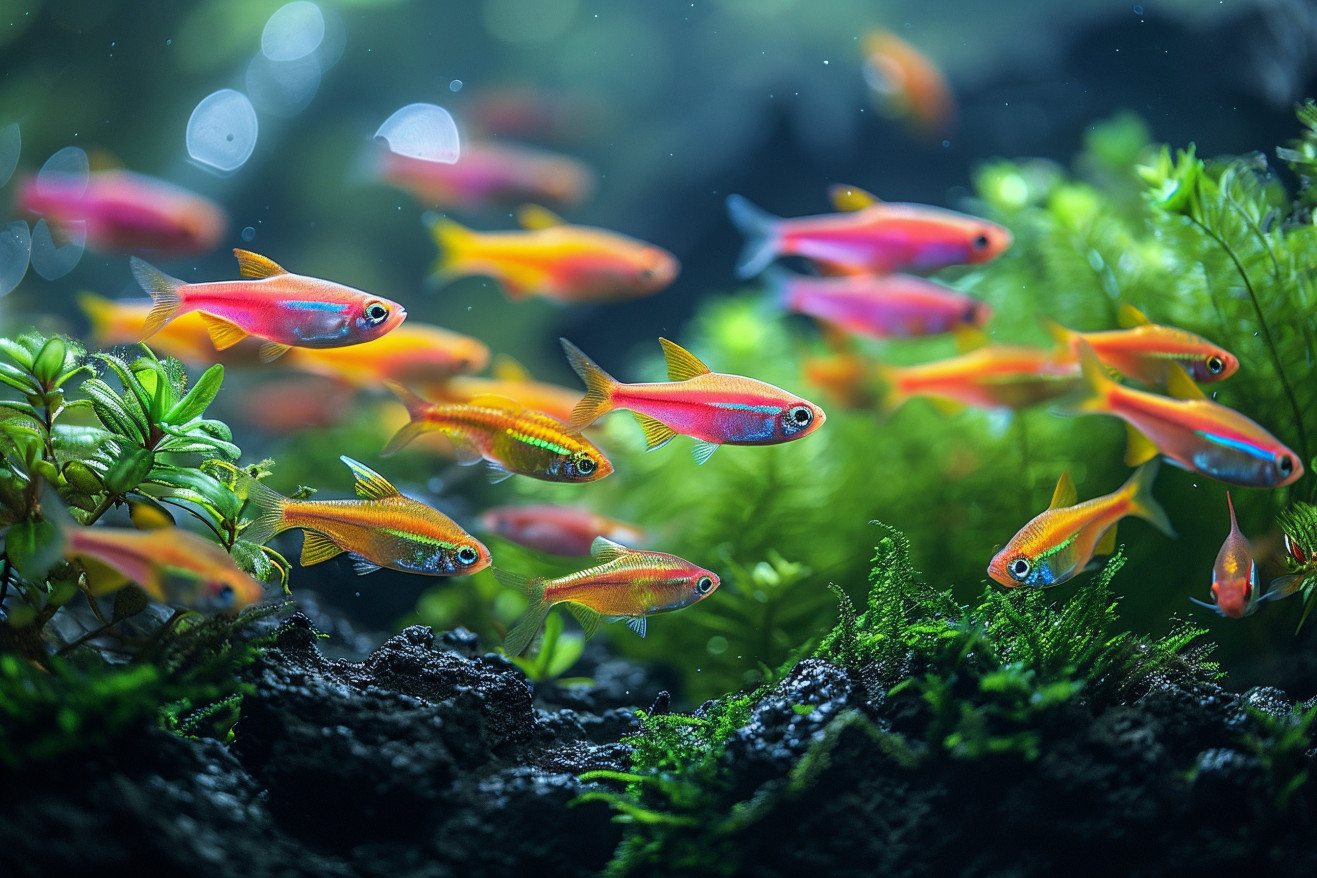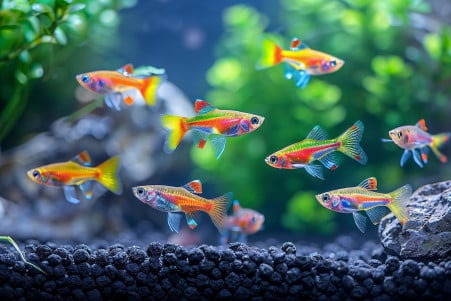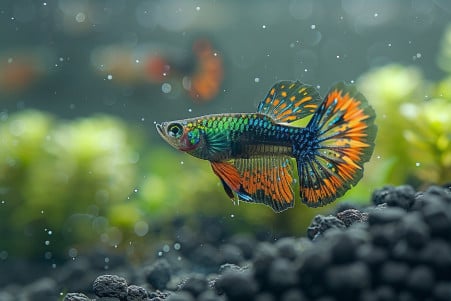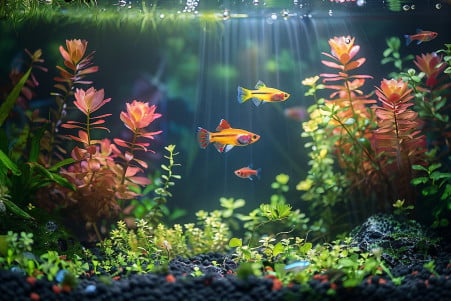The Best Fish Stocking Level for a 20-Gallon Tank: Quantities & Suggestions
8 February 2024 • Updated 8 February 2024

Trying to figure out the fish-per-gallon rule for a 20-gallon tank requires a deep understanding of fishkeeping. The general rule of thumb for a 20-gallon tank is to add 1 inch of small fish per gallon, which means you can start with 15–20 small fish like Tetras.
However, you also need to think about fish size, fish behavior, and the conditions in the tank. If you add too many fish, the tank can become overcrowded, which can lead to poor water quality and stress for the fish.
This article will take a deep dive into the interdisciplinary world of fishkeeping, which includes ichthyology, the study of fish, fish behavior, and aquarium science.
Using research and expert advice, we will explore bioload capacity, the needs of different species, and the importance of maintaining a healthy ecosystem in your tank. By the end, you will have a solid understanding of these factors and be able to create and maintain a healthy, happy community in your 20–gallon tank.
What is the ideal stocking level for a 20-gallon tank?
How to Stock a Fish Tank: Beyond the One-Inch-Per-Gallon Rule
While the one-inch-per-gallon rule can quickly help you determine how many fish a 20-gallon tank can hold, it is also very limiting. As PetHelpful explains, the one-inch-per-gallon rule is based on the idea that each inch of an adult fish needs one gallon of water.
However, this doesn’t take into account the adult size of the fish, the waste produced by different species, and the behaviors of different species, all of which determine the bioload capacity of your tank—the amount of waste your fish produce and the tank’s ability to handle it biologically.
It is important to take into account the nitrogen cycle, a crucial biological filtration process in which beneficial bacteria convert ammonia into less toxic substances, which is essential to maintaining a healthy ecosystem in your aquarium. If the nitrogen cycle is not accounted for, it can put your fish in danger.
To get a more accurate idea of how many fish your tank can hold, consider the adult size of your fish using the INJAF-recommended resources FishBase.org and SeriouslyFish.com.
It’s also important to remember that it’s always better to understock your tank. This will help ensure that your fish have enough room to grow and that the environment in your tank is stable, which leads into a discussion of how water quality impacts fish health.
Why Water Quality Is So Important for Fish Health
The connection between water quality and the health of fish is clear—fish need the right environment to thrive. In an interview, fish veterinarian Dr. Jessie Sanders said that water quality is the most important factor in determining fish health. Poor water quality can cause stress, suppress the immune system, and lead to an increased likelihood of disease.
In a 20-gallon tank, it’s important to keep a close eye on parameters like pH, which should be between 6.8 and 7.8, and the nitrogenous compounds ammonia, nitrite, and nitrate. Ammonia and nitrite should be at zero, as they are toxic even at low levels. Nitrates are less toxic but should be kept below 50 ppm to prevent stress and health problems.
To prevent poor water quality, Dr. Sanders recommends regular testing with reliable kits, like the API Freshwater Master Test Kit. In addition, experts agree that it’s important to stick to a regular schedule of partial water changes to help remove harmful chemicals and replenish important minerals.
When poor water quality does occur, it’s important to take immediate action, including increasing aeration, doing daily water changes, and using a gravel cleaner to remove debris.
By keeping an eye on these water quality measures and taking action when they fall out of the desired range, you can maintain the delicate balance necessary for your fish’s health, creating a tank environment that meets both the physical and behavioral needs of your fish.
Serene Aquarium Society: Social Dynamics and Fish Stocking
When stocking a 20-gallon tank, understanding the social behavior of fish is just as important as understanding their environment.
Each type of fish has a different social structure and set of social needs and behaviors that can have a big impact on how many fish can be stocked in a tank.
For example, territorial fish like cichlids need enough room to establish their territory, which limits the number of other fish that can be in the tank. Ratemyfishtank explains that changes in behavior, like increased aggression and the establishment of a pecking order, are signs of stress and mean that the situation needs to be addressed.
Aqueon explains that territory, pecking orders, and schooling behaviors are all important when it comes to determining how well fish will get along in a tank. For example, tetras and barbs are schooling fish and need to be kept in groups, and they need other fish in the tank to help them feel safe. On the other hand, bettas and gouramis are often best kept alone because they are aggressive fish.
To make sure fish will get along, it’s important to choose fish that are compatible with one another and to keep an eye on their interactions. Petfish recommends adding hiding places and lots of plants to the tank to act as natural barriers that will help prevent conflicts. These things will give fish places to hide and create visual barriers that will help reduce stress and aggression.
Carefully decorating the tank to mimic natural environments will help fish feel more comfortable and will give less dominant fish places to hide. This underscores the significance of the filtration system in preserving the health and equilibrium of a 20-gallon tank, as it’s important to sustain the precise balance of the underwater world.
Optimal Filtration: How to Keep Your 20–Gallon Tank Healthy
The importance of the filtration trinity—biological, chemical, and mechanical—cannot be overstated when it comes to maintaining a healthy environment in a 20-gallon tank. Biological filtration, which is carried out by beneficial bacteria, as explained by The Spruce Pets, helps convert ammonia and nitrites into nitrates, which are less harmful and an important part of the nitrogen cycle.
Chemical filtration media, such as activated carbon, helps remove dissolved waste, and mechanical filtration media helps remove solid waste, which is important for maintaining water clarity and preventing the buildup of harmful substances.
A good filtration system will also be able to handle a larger bioload, which means that it can cycle and clean the water more effectively, even if there are more fish in the tank.
Aqueon explains that when choosing a filter, you should take into account the size of the tank, the type of fish, and the feeding habits of the fish; for example, a tank with larger fish that eat messier foods may require a more powerful filter.
In many cases, when you notice that a filter isn’t working properly, such as when the flow rate decreases or the filter becomes noisier, you can fix the problem by cleaning or replacing the filter media.
Keeping the water clean and safe for fish through proper filtration is essential for maintaining a healthy fish tank. However, when you’re thinking about filtration in a 20-gallon tank, it’s also important to think about the future.
A good filter won’t just meet the needs of the current bioload, but it will also be able to handle the needs of the fish when they’re fully grown, and this is something that needs to be considered when you’re thinking about the long-term care of a fish tank.
Future Planning: How to Account for Fish Growth in a 20-Gallon Tank
One of the most important things to keep in mind when stocking a 20-gallon tank is the potential size that your fish will grow to. According to INJAF, fish will not grow to the size of their tank, but they will grow to the size of their species if given the right conditions.
This myth-busting shows that fish will not grow to the size of their tank, but if you don’t account for the size of the fish you’re adding to your tank, you can run into problems like overcrowding and the health issues that come with it, including stunted growth and a weakened immune system.
The quality of a fish’s diet and water quality are both important factors in their growth. As The First Tank Guide explains, poor diet and water quality can lead to stunted growth and a variety of other health problems. This means that providing a healthy diet and maintaining good water quality are both important for the health of your fish.
To make sure that you’re well aware of the size that your fish will grow to, you can look at reputable sources like FishBase.org and SeriouslyFish.com, which provide detailed information about a wide range of species. By knowing the full size and bioload of your fish, you can make sure that you’re setting up a healthy environment for them in your 20-gallon tank that will support their long-term health and well-being.
Building a Healthy Home: The Science of Stocking a 20-Gallon Tank
The challenge of stocking a 20-gallon tank successfully is a study in the many variables that must come together to create a healthy tank. As a result, the general rule of thumb of 1 inch of fish per gallon is just a jumping-off point.
Aquarium Nexus says that you should also take into account the adult size of the fish, their activity level, water quality, and the capacity of the tank’s filter to make sure that you don’t overstock your tank and that your fish can live comfortably.
Hygger stresses the importance of patience in setting up a new tank and recommends that you add fish slowly to give the tank’s filter time to mature.
So, as a responsible fishkeeper, it’s up to you to do your homework, learn about your fish’s needs, and, as Tropical Fish Care Guides suggests, plan for their adult size and set up a tank that meets their needs and is as close to their natural environment as possible.
In the end, the heart of fishkeeping is the dedication to creating a healthy, sustainable, and humane environment for your fish. By combining an understanding of stocking levels, water quality, and fish behavior, you can create a safe space where your fish will thrive. So, go forth and be a responsible fishkeeper and bring a little piece of the ocean into our homes.


